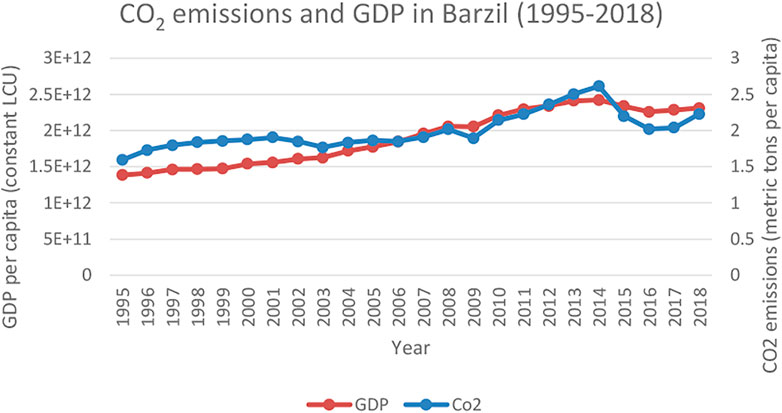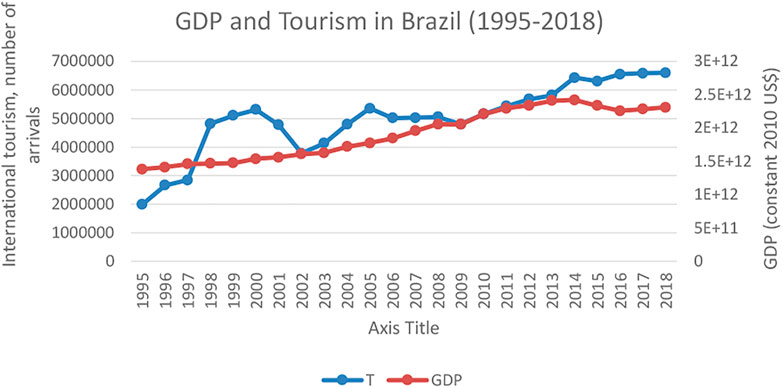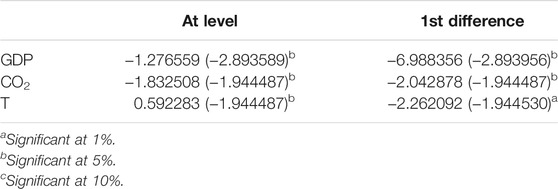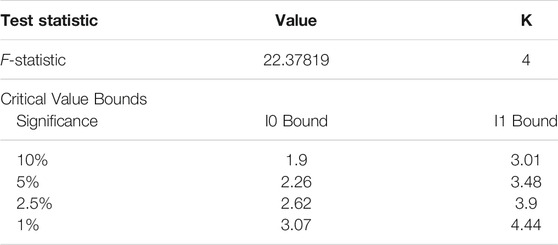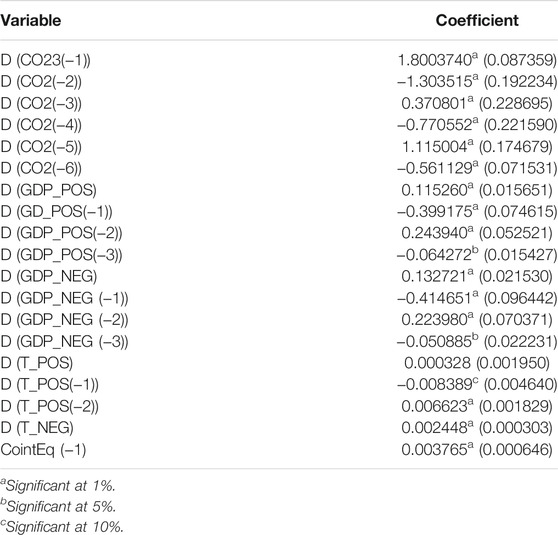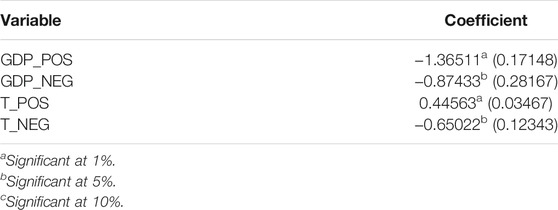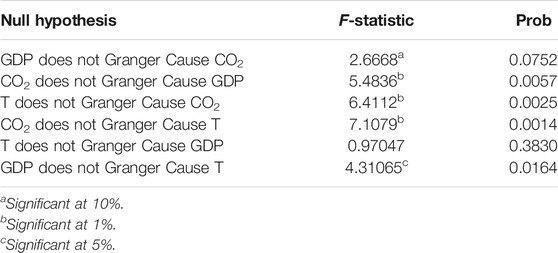Investigating Relationships Between Tourism, Economic Growth, and CO2 Emissions in Brazil: An Application of the Nonlinear ARDL Approach
- 1Reading Academy, Nanjing University of Information Science and Technology, Nanjing, China
- 2Faculty of Management Sciences, National University of Modern Languages, Islamabad, Pakistan
- 3Department of Economics, University of Hradec Kralove, Hradec Kralove, Czechia
- 4International Business School, Guangzhou College of South China University of Technology, Guangzhou, China
- 5School of International Education, Wuxi University, Wuxi, China
- 6College of Business Administration, Liaoning Technical University, Fuxin, China
- 7Lahore Business School, University of Lahore, Lahore, Pakistan
Global tourism has witnessed a significant positive implication on the development of developing economies. Despite the positive implication of tourism, it imposes a serious environmental cost such as environmental pollution. Brazil receives a large number of tourists each year that potentially affects economic growth and development. Therefore, this study investigates the effect of tourism on GDP and CO2 emissions in Brazil. We used a nonlinear ARDL approach to examine the nexus between tourism, economic growth, and CO2 emissions in Brazil for the period 1995–2018. The outcomes of this study reveal both short-run and long-run associations between tourism, GDP per capita, and CO2 emissions in Brazil. Nevertheless, both tourism and economic growth cause significant deterioration of the environment quality in Brazil. These findings suggest that the policymakers shall look for more sustainable and eco-friendly economic growth and tourism policies to preserve the environmental quality in Brazil.
Introduction
The global tourism industry has changed remarkably with exponential growth in tourism demand in the past few decades. This trend consequently causes environmental degradation and a high level of energy consumption at the tourist destination. The ultimate effect of high energy consumption results in environmental pollution, mostly in the form of CO2 emissions. The CO2 emission from the last few decades as a result of global warming has become a growing concern of researchers. The CO2 emissions, as the leading contributor to global warming, have nearly quadrupled since the early 1960s (Koçak et al., 2020; Adebayo and Kirikkaleli, 2021; Shahzad et al., 2021). Global warming has adverse implications for the economy, government, lifestyle, and social and geopolitical development (Bilgili et al., 2016; Adebayo and Rjoub, 2021). Global warming and climate change have caused millions of people to suffer from hunger, disease, floods, and water shortages (Escobar et al., 2009). The World Health Organization (2018) reported poor air quality levels in several cities in the low- and middle-income countries with a population of more than 100,000. An earlier assessment by the World Health Organization (2016) reported about 7 million premature deaths due to air pollution The CO2 emissions are perceived as the cost of tourism due to various tourist activities. Therefore, it raised concerns about the adverse effects of energy use in the tourism industry. Therefore, it is imperative to assess the potential future effects of tourism on environmental quality, especially for the economies in which tourism has a significant contribution towards GDP.
Tourism has shown a profound positive influence on the economic growth across the globe in the last 4 decades, and this sector has emerged as an important driver in the process of economic development for both the developed and developing countries (Li and Lin, 2015; Cetin et al., 2018; Park et al., 2018; Cannonier and Burke, 2019; Chai et al., 2019; Kirikkaleli et al., 2021). Blake et al. (2006) compare the effects of the productivity of various tourism sectors on economic development and found that the tourism sector has a significant positive effect on economic development. Liu et al. (2018) employ the exogenous economic growth theory by assuming that productivity is exogenous with a diminishing return to the capital. They presented tourism activity as an exogenous tourism productivity shock to economic growth using the case of Mauritius under the dynamic stochastic general equilibrium (DSGE) model. Their findings posit that tourism creates employment opportunities; brings foreign capital inflow; improves infrastructure; provides significant contributions to the development of manufacturing, agriculture, and service sectors; increases the revenue of hotel business; and thus has an overall positive impact on the economy (Zaman et al., 2017; Zhou et al., 2018; Koçak et al., 2020). Despite the benefits of tourism for the economy, it also has some adverse effects, for instance, the pollution issue. Due to escalated economic activities and energy consumption, tourism significantly contributes towards the CO2 emissions in an economy. Hence, tourism is an important factor that directly or indirectly affects the local as a well global ecosystem. According to the UNWTO Tourism statistics, international tourist arrivals recorded a 7% growth and international tourism receipts increased by 4.9% in 2017. Tourism contributed towards revenues from international passenger transport services by 240 billion USD. In addition, tourism ranks third in the global export earnings category after chemicals–fuels and the automotive sector in 2017 (UNWTO, 2018; Shahzad et al., 2020). Tourism epitomized approximately 3.5% of economic growth and approximately 3.5% of total employment in Brazil’s economy in 2014 (WTTC, 2018). While tourism is not a recent phenomenon in Brazilian society, mass tourism certainly is.
Previous studies have explored the negative impacts of tourism activities on the host country’s environment for different countries including France, Spain, the United States, China, Italy, Mexico, the United Kingdom, Turkey, Germany, and Thailand. Their findings suggest that tourism has an adverse effect on the environment quality (Lee and Brahmasrene, 2013; Tang et al., 2014; Aziz et al., 2020). Though it boosts the transportation, catering, and accommodation businesses in the host country (Nepal, 2008; Howitt et al., 2010; Rosselló-Batle et al., 2010; Scott et al., 2010; Lee and Brahmasrene, 2013). The environmental degradation is a complimentary phenomenon with the development process, industrialization, and economic growth. Extant literature also pointed out some other factors responsible for the environmental degradation, including population growth, urbanization, trade, energy consumption, foreign direct investment, and financial development (Li and Lin, 2015; Cetin et al., 2018; Dong et al., 2018; Nasrollahi et al., 2018; Park et al., 2018; Kirikkaleli and Adebayo, 2021).
Tourism in Brazil is a growing sector that has a significant contribution to the development of the economy. In 2018, 6.589 million tourists visited Brazil. In addition, Brazil ranks as the third top tourist destination in Latin America after Mexico and Argentina. This study investigates the association between economic growth, tourism, and CO2 emissions to assess the implications of economic and tourist activities on the environmental quality using the case of Brazil. Brazil is a very significant BRICS economy, whose substantial economic growth, tourism, and GDP together lead to a high level of energy consumption and CO2 emissions. Therefore, it is essential to explore the nexus between tourism, GDP, and CO2 in Brazil. This study contributes to the existing literature from the following aspects: firstly, there are a few studies that explore tourism for GDP and CO2 emissions for Brazil. However, they used linear methods of analysis; this study provides a more detailed analysis by using nonlinear Autoregressive Distributed Lag (ARDL) tools, which are capable of capturing the nonlinear relationship between tourism, CO2 emissions, and GDP. Secondly, most of the studies did not capture the short-run and long-run relationship between tourism, GDP, and CO2 emissions; the nonlinear ARDL approach provides a comprehensive analysis for both short-run and long-run relationships among the variables. The application of nonlinear models is particularly important because it captures dynamic relationships among the variables and is closer to reality. Most of the variables have dynamic trends and conventional linear models do not accurately capture the actual association between the variables, but the nonlinear model provides a reasonable prediction. The rest of the paper is organized as follows. Literature Review entails the detailed review of literature, The Case of Brazil: Stylized Facts presents the stylized facts of Brazil, The Case of Brazil: Stylized Facts and Methodology presents the methodology and empirical results, and Empirical Analysis concludes the study.
Literature Review
Tourism and Economic Growth
The impact of tourism on economic growth can be elaborated through the tourism-led growth hypothesis, which posits that the development of tourism leads to economic growth (Gwenhure and Odhiambo, 2017). Various theoretical frameworks supported this hypothesis; Dornbusch et al. (2014) follow the endogenous growth model by introducing the tourism factor in terms of technological investment and skill development, which stimulate economic growth in an economy. In addition, tourism provides employment opportunities for unemployed, low, and unskilled labor, which leads to economic development (van der Schyff et al., 2019). Various studies have investigated the relationship between tourism and economic growth. Akama (2016) used tourism and economic growth data from 1980 to 2013 in Kenya; they reported that economic development can be achieved by improving local tourism. Bento (2016) confirmed the tourism-led hypothesis for economic growth in Portugal. Similarly, Arslanturk et al. (2011) used the input–output method and exhibited that tourism contributes to economic growth in Turkey. Likewise, Shahzad et al. (2017) examined the tourism-led hypothesis in Mexico and found that the development of tourism has positive impact on economic growth.
The findings from a majority of the research related to tourism impact on economic growth can be subdivided into three groups. The first group of studies concludes that there is a unidirectional association between tourism development and economic growth. Khoshkhoo et al. (2017) using the input–output model revealed that the development of tourism industry in Iran significantly promoted local economic development. Likewise, a study reported a long-run positive association between tourism, economic growth, and employment in Pakistan (Manzoor et al., 2019). Govdeli and Direkci (2017) used data of 34 OECD countries from 1997 to 2017 and found that development of tourism opportunities enhances economic growth in these countries. The second group of researchers contend, though, that development in the tourism industry and economic growth reinforce each other due to a bidirectional causal relationship. For example, the study of Roudi et al. (2019) used Granger causality analysis and observed that development of tourism creates economic development in small island states. Likewise, economic growth also positively impacts tourism growth. Similarly, Besel and Uğur (2017) employed time-varying causality analysis and Fourier co-integration techniques and found a bidirectional causal linkage between tourism development and economic development in Turkey. Notwithstanding, the third group of studies assert that tourism development does not affect economic growth. As shown by the work of Arslanturk et al. (2011) and Kokotovic (2017) using vector error correction mechanism for Turkey, Croatia, and Czech Republic, respectively, they rejected the tourism-led economic growth hypothesis for these countries.
Tourism and the Environment
Tourism is a fast-growing economic activity. In 2017, tourism contributed 10% of the world’s total GDP. Besides, it assumes one-tenth of total jobs and has 7% share in global trade (UNTWO, 2018). Globally, tourism industry has exhibited tremendous growth in the last few decades despite the socio-political instability and economic crisis (Paramati et al., 2017). Although tourism contributes to economic growth and job creation, at the same time, it deteriorates the eco-system by increasing the environmental waste and escalating carbon emissions (Shi et al., 2019). Policymakers are also under immense pressure for the ongoing and ever-increasing environmental problems of global warming and climate change caused by an extremely high level of carbon emissions. The world development indicator on carbon emissions states that carbon emissions in 2014 have increased 300% as compared to the emissions in 1968. Perhaps it is due to these severe issues that the discussion of sustainable and low carbon emission economies has emerged to reduce the level of emissions, which is causing significant damage to the ecological system.
Various studies have investigated the impact of tourism activities on environmental degradation and pollution in different countries using a variety of methods. The studies by Lee and Brahmasrene (2013), Tang et al. (2014), and Tang et al. (2017) found that tourism has adverse effects on environmental quality due to increasing levels of carbon emissions while transportation activities constitute a major portion of the total carbon emissions. The study of Gössling (2002) revealed that land degradation and the use of fossil fuel have further magnified environmental problems including global warming and climate change. Transportation and accommodation activities are directly linked to tourism and contribute 4.4% towards the total carbon emissions (Peeters and Dubois, 2010). It is, therefore, asserted that higher energy consumption and deterioration of the environment is a major cause of carbon emissions caused by tourism development (Zhu et al., 2021). Hall et al. (2013) argued that tourism not only boosts economic activity, but also increases carbon emissions; hence, its further effects on climate change are an important challenge for policymakers.
Economic Growth and the Environment
The most essential factor for achieving sustainable development is the preservation of environmental quality (Kyoto Protocol to the United Nations, 1997). Higher energy consumption for achieving fast-paced economic growth causes significant degradation in environmental quality. Economic growth is characterized by urbanization, industrialization, and improvement in transportation infrastructure, causing a higher level of energy consumption that ultimately compounds carbon emissions. Various studies have been carried out for examining the relationship between economic growth and carbon emission from a single-country and multi-country perspective. Using the case of China and employing cointegration and causality analysis, the results show that CO2 emissions lead to an upsurge in the current as well as future economic growth (Lv et al., 2019). Likewise, Abid (2015) examined the relationship between economic growth and carbon emissions for Tunisia from 1980 to 2009. The Granger causality test and vector error correction mechanism were used for empirical investigation. The results confirmed a unidirectional causality between economic growth and carbon emissions and found a monotonically growing relationship between these two aspects in Tunisia. Yang et al. (2015) tested the causal relationship between tourism and carbon emissions among 71 countries from 1971 to 2010. The association among various variables was found to be dynamic in nature because of various patterns of development and region-specific characteristics. The developing countries show monotonically aggregate models and inverted U-shaped curves. On the other hand, developed countries show inverted M-shaped and N-shaped models to depict this association. Ahmad et al. (2017) examined the environmental Kuznet Curve (EKC) from 1992 to 2011 in Croatia. The VECM and ARDL models were used to test the relationship between carbon emissions and economic growth. A bidirectional causality based on VECM was reported in the short run and a unidirectional causality was observed in the long run. Besides, an inverted U-shaped association between economic growth and carbon emission was found in the long run, hence validating the EKC hypothesis. Bano et al. (2018) studied the impact of economic growth and human capital on carbon emissions in Pakistan from 1971 to 2014 using VECM and ARDL techniques. Results of the Granger causality suggest no short-run relationship between economic growth and carbon emissions, whereas carbon emission causes economic growth in the long run. Jardón et al. (2017) carried out research on 20 Caribbean and Latin American countries to test the relationship between economic growth and carbon emissions using data from 1971 to 2011. Results of EKC hypothesis exhibited an inverse U-shaped relationship with a carbon emission and economic growth. The research on exploring the nexus between CO2 emissions and economic growth has mainly concentrated into two streams. The first stream of literature suggests an inverted U-shaped relationship between environmental pollutants and economic growth, which is known as the Environment Kuznets Curve (EKC), though recent studies on EKC revealed that there exists an inconsistent association between CO2 emissions and economic growth (Fang et al., 2019). However, results from these studies are highly contingent upon regional and country-level specific dynamics. The second stream of literature examines the relationship between energy consumption and economic growth such as Grossman and Krueger (1995). The empirical findings of their study postulate varying linkages between energy consumption and economic growth. This dynamic association can be attributed to the choice of datasets, model specifications, and the econometric technique involved.
The Case of Brazil: Stylized Facts
CO2 Emissions and GDP
Figure 1 depicts a graphical trend between carbon emissions and growth in GDP per capita in Brazil. GDP growth posts an upward movement from 1995 to 2014 and a downward trend afterward up to 2016. Subsequently, GDP again reveals a growth trend up to 2018. Similar variations can be observed in carbon emissions during the same period. Carbon emissions in Brazil increased between 2008 and 2014 and a visible decreasing trend is observed afterward up to 2017, though a sudden rise is exhibited in 2018. Overall, the movement of CO2 and GDP suggests a direct association between these two variables in the context of Brazil. This pattern conjectures that the Brazilian government is not deploying green technology; therefore, the country is experiencing a higher level of pollution emissions. Hence, the government should encourage the use of eco-friendly technologies to reduce the amount of emissions without a slump in the GDP growth. However, the nexus between economic growth and the environment needs to be explored further to ensure sustainable economic growth and development.
GDP and Tourism
Figure 2 shows the co-movement between GDP and tourism in Brazil. It depicts an upward trend for both the GDP and tourism in Brazil. Though GDP is increasing steadily as compared to tourism growth, various shocks can be observed in the number of tourism arrivals in Brazil. Nevertheless, tourism activities have posted an upward growth from 1995 to 2000, which is attributed to the incentives and rebates offered by the government to entice more tourist inflow. However, a decreasing trend in tourism arrivals can be observed from 2000 to 2003, which is mainly due to the various taxes levied by the government. The period between 2010 and 2018 shows a marked increase in tourism arrivals in Brazil. Overall, the graph suggests that GDP has an indirect positive co-movement with tourism. Tourism revenues boost government revenues, household income, and increase employment opportunities, therefore leading to economic growth and prosperity for a country.
Tourism and CO2 Emissions
Figure 3 demonstrates the trend between tourism and carbon emissions in Brazil. Carbon emissions show an upward movement from 1995 to 2014 and a visible decrease can be observed from 2014 to 2017. Tourism arrivals post an upward trend from 1995 to 2000 and a downward trend can be observed from 2000 to 2003. Tourism activities in Brazil as shown in the figure increased from 2003 to 2006, showing a decreasing trend up to 2010 and then onward have shown a visible increase in tourist activities in Brazil. The overall trend suggests that a huge increase in tourism volume brings a slight upward increase in the amount of CO2 emissions, which confirm somehow a direct link between tourists’ arrivals and CO2 emissions. Tourism plays an important role in economic growth, but at the same time, tourism has its share of environmental concerns as tourist activities are among the major cause of carbon emissions. The environmental concerns from tourism and its allied economic benefits need to be balanced in the form of low carbon emission and high income for the tourism industry.
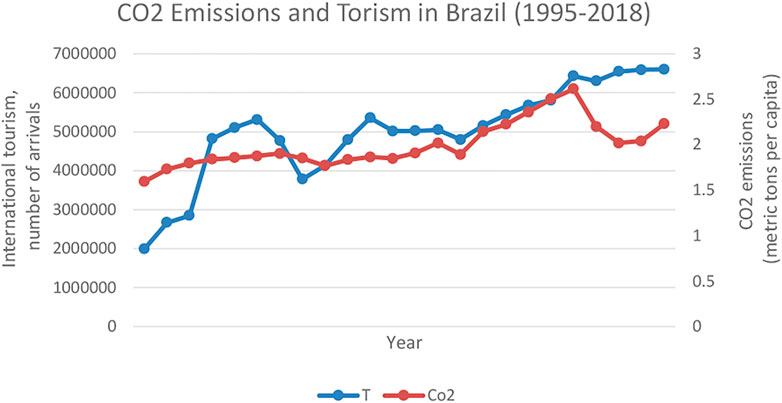
FIGURE 3. CO2 emissions and tourism in Brazil (1995–1918). Source: World Development indicators (2020).
Methodology
The study used the following econometric model for the empirical estimation:
Where the error term
GDP = Gross Domestic Product.
T = Tourism (total number of arrivals).
The model entails CO2 emissions as the dependent variable to proxy the environmental quality, GDP per capita is an independent variable, and gross domestic product is a measure of the aggregate economic activity in the economy. T represents tourism; we take the number of tourists arrival in the country. Since, theoretically, both tourism and GDP have a perceived positive association, coefficients like β1 and β2 are assumed to have a positive expected sign. The error term is assumed to be uncorrelated with the explanatory variables (World Bank, 2021). The data for all induced variables are obtained from the World Bank database from 1995 to 2019. GDP is taken at Constant US dollar; T is the number of tourist arrivals and CO2 emissions are taken as the emissions per metric ton. Before proceeding with the non-ARDL estimation, we first start with the linear ARDL framework to show the long-run and short-run association between the variables. Eq. 1 presents the mathematical expression for the linear ARDL framework as follows.
If the outcomes reveal cointegration among the variables like in our case “CO2 emissions, GDP, and Tourism,” then any short-run deviation will adjust to the long-run equilibrium. In other words, the short-run deviation will ultimately achieve the long-run equilibrium. The “
In Eq. 3, the coefficients of the variables use “
The above equations show positive and negative shocks of the GDP and T (i.e., GDP+ and GDP−, and T+ and T−). The negative–positive components show the increasing and decreasing effects of each variable. The fact that there are two time series, one being positive and the other being negative in the Granger framework, suggests a hidden cointegration in this case. In order to test the long-run relationship, Pesaran et al. (2001) used the following equation:
Empirical Analysis
This section provides the detailed outcomes of nonlinear ARDL. Table 1 shows the ADF unit root results by using the stationarity analysis. Although the same order of stationarity is not prerequisite for the long-run relationship, it helps to understand the order of integration. We used the Schwarz information criterion (SIC) for the optimal lags selection including the constant and trend term in the ADF unit root equation. The ADF unit result shows that all the variables are not stationary at level and become stationary at first level. Therefore, we can proceed to use the bound test.
The long-run estimations are sensitive to the optimal lag selection in estimations. Bahmani-Oskooee and Bohl (2000) and Stock and Watson (2012) indicate that fewer lags are not capable to capture full information from the model. Contrary to this, higher lags lead to “over-fits” of the model. Therefore, optimal lag selection is one the prerequisite for the accurate results. SIC criteria are used for the optimal lags for our model. Table 2 reports the bound test results, which contains the F-statistics and the relevant lower and upper bound values. The table results presented in Table 2 show that F-statistics values for both linear and nonlinear model are higher than the upper value, which indicates the existence of cointegration in the model.
We estimated equation (12) by using the general AIC lag criteria for optimal lag length. We drop those variables that were not significant to avoid inaccurate analysis as such results can create noise in the dynamic multipliers. Table 3 shows the initial ARDL outcomes; the model has been tested through various diagnostic tests for the validity of outcomes. The diagnostic results included the Breusch/Pagan heteroscedasticity test, Ramsey RESET test, and Jarque-Bera test on normality, which reported no issue of heteroscedasticity, serial correlation, and normality in the error term or residuals.
The long-run estimations are reported in Table 4, which contains both positive and negative shocks of the explanatory variables. The positive shocks indicate a negative relationship between CO2 emissions and GDP; this implies that due to the development of new low-carbon technologies in the boom period, the output that emits less CO2 is provided; this association is in line with Kasperowicz (2015). However, in the long run, during the recession period when GDP is declining, an increase in GDP increases the CO2 emission, which indicates that GDP growth is a significant source. The positive shocks of tourism hold positive, and significant implications on CO2 emissions imply that the number of tourist arrivals leads to high energy consumptions, which leads to CO2 emissions. The negative shocks lead to a decrease in CO2 emissions, which implies that a decrease in the number of tourists reduces CO2 emissions.
The Granger causality test in Table 5 reports the casual linkages between CO2 emissions, GDP, and T. The results show bivariate causality between CO2 emissions and GDP. There is a univariate causality from CO2 emissions to T, though no causality is found from the T to CO2 emissions. Likewise, there is a univariate causality from GDP to T. The Granger causality outcomes further verify the baseline NARDL model estimations; as the GDP causes CO2 emissions due to high level of economic activities, tourism also causes CO2 emissions due to a high level of energy use and increase in the aggregate consumption in the economy. The results of this study resemble those of Lee and Brahmasrene (2013), Jardón et al. (2017), Govdeli and Direkci (2017), Chengcai Tang et al. (2017), and Zhu et al. (2021).
Conclusion
Brazil is the largest economy in Latin America and has a substantial contribution towards CO2 emission in the region, which has far-reaching effects on social and environmental indicators. Besides the sluggish performance in some years, the tourist inflows to Brazil have increased continuously during the study period. Being a rapidly growing economy and having a huge influx of tourists have serious repercussions for the environmental quality in the country. Therefore, this study investigates the relationship between CO2 emissions, tourism (T), and economic growth in Brazil. We employ time series data from 1995 to 2018 and employ the nonlinear ARDL method of estimation, which provides more realistic empirical outcomes as compared to the conventional liner estimation methods like linear ARDL. The nonlinear ARDL model is capable of capturing the realistic scenario regarding the association between the variables. The empirical results depict the long-run and short-run association between CO2 emissions, GDP, and tourism. Besides, both GDP and tourism contribute to the CO2 emissions through either negative or positive shocks as exhibited by the nonlinear ARDL estimations. This implies that tourist activities increase the energy consumption in the economy, which leads to higher CO2 emissions. Moreover, the aggregate increase in demand also leads to higher consumption in the economy. Likewise, GDP growth is predominantly fueled by the energy consumption during the production process, which is also a leading contributor towards the CO2 emissions in the economy.
Based on these findings, the study suggests that the government shall support the carbon-neutral policies of the UNWTO (2018) at the national level. In this context, Brazil may roll out various policies to reduce the pollutant emissions in the economy. (1) The transportation sector is the major producer of CO2 emissions as the basic fuel needs of transportation vehicles (air, road, railroad, and water) mainly depend on fossil energy sources (Sharma and Ghoshal, 2015; Koçak et al., 2020). Therefore, the government may encourage the use of alternative fuels and hybrid technologies particularly in the transport services (Raza et al., 2017). (2) The government can implement well-defined environmental quality rules; for example, tourist spots with more adverse effects on the environment should allocate sufficient funds for environmental restoration in order to preserve environmental quality. (3) The public sector may promote renewable and clean energy production in the economy particularly in the tourist destinations by using subsidies or tax exemptions. (4) Environment quality can be enhanced by implementing certified carbon credit policies and encouraging projects such as tree plantation drives, renewable energy production, and energy savings, and through effective environmental education and awareness. The implementation of these strategies can substantially improve the ecosystem and help to reduce CO2 emissions in Brazil. The study is not without limitations, though, as it only focuses on a single country. Besides, it only covers the period 1995–2018 due to data unavailability for the preceding years. This research can be extended to various dimensions. It will be interesting to see the impact of CO2 emissions in tourist destinations on the health of the native population living in these regions. Nevertheless, it would be interesting to use forecasting techniques such as the neural network to predict the long-term impact of tourism on the environmental quality of a country. The current study has certain limitations; in the future, researchers should consider developed and developing regions and may include other important variables such as globalization and culture influences to better explain this relationship.
Data Availability Statement
Publicly available datasets were analyzed in this study. This data can be found here: https://databank.worldbank.org/source/world-development-indicators.
Author Contributions
Conceptualization: MHS. Methodology and software: AR. Formal analysis: MZ. Data collection: MZ. Writing-original draft preparation: LS. Writing-review and editing: IU. Supervision: AA. All authors have read and approved the manuscript.
Funding
This research was supported by the Project Excellence 2022 (the University of Hradec Kralove, Faculty of Informatics and Management), a Long-term development plan of the University of Hradec Kralove.
Conflict of Interest
The authors declare that the research was conducted in the absence of any commercial or financial relationships that could be construed as a potential conflict of interest.
Publisher’s Note
All claims expressed in this article are solely those of the authors and do not necessarily represent those of their affiliated organizations, or those of the publisher, the editors, and the reviewers. Any product that may be evaluated in this article, or claim that may be made by its manufacturer, is not guaranteed or endorsed by the publisher.
References
Abid, M. (2015). The Close Relationship between Informal Economic Growth and Carbon Emissions in Tunisia since 1980: The (Ir)relevance of Structural Breaks. Sustain. Cities Soc. 15, 11–21. doi:10.1016/j.scs.2014.11.001
Adebayo, T. S., and Kirikkaleli, D. (2021). Impact of Renewable Energy Consumption, Globalization, and Technological Innovation on Environmental Degradation in Japan: Application of Wavelet Tools. Environ. Dev. Sustainability 23, 16057–16082. doi:10.1007/s10668-021-01322-2
Adebayo, T. S., and Rjoub, H. (2021). A New Perspective into the Impact of Renewable and Nonrenewable Energy Consumption on Environmental Degradation in Argentina: a Time–Frequency Analysis. Environ. Sci. Pollut. Res. 29, 16028–16044. doi:10.1007/s11356-021-16897-6
Ahmad, N., Du, L., Lu, J., Wang, J., Li, H.-Z., and Hashmi, M. Z. (2017). Modelling the CO2 Emissions and Economic Growth in Croatia: Is There Any Environmental Kuznets Curve? Energy 123, 164–172. doi:10.1016/j.energy.2016.12.106
Akama, E. (2016). International Tourism Receipts and Economic Growth in Kenya 1980-2013. Available at: https://mpra.ub.uni-muenchen.de/78110/.
Arslanturk, Y., Balcilar, M., and Ozdemir, Z. A. (2011). Time-varying Linkages between Tourism Receipts and Economic Growth in a Small Open Economy. Econ. Model. 28 (1-2), 664–671. doi:10.1016/j.econmod.2010.06.003
Aziz, N., Mihardjo, L. W., Sharif, A., and Jermsittiparsert, K. (2020). The Role of Tourism and Renewable Energy in Testing the Environmental Kuznets Curve in the BRICS Countries: Fresh Evidence from Methods of Moments Quantile Regression. Environ. Sci. Pollut. Res. 27 (31), 39427–39441. doi:10.1007/s11356-020-10011-y
Bahmani-Oskooee, M., and Bohl, M. T. (2000). German Monetary Unification and the Stability of the German M3 Money Demand Function. Econ. Lett. 66 (2), 203–208. doi:10.1016/s0165-1765(99)00223-2
Bano, S., Zhao, Y., Ahmad, A., Wang, S., and Liu, Y. (2018). Identifying the Impacts of Human Capital on Carbon Emissions in Pakistan. J. Clean. Prod. 183, 1082–1092. doi:10.1016/j.jclepro.2018.02.008
Bento, J. P. C. (2016). Tourism and Economic Growth in Portugal: An Empirical Investigation of Causal Links. Tms 12 (1), 164–171. doi:10.18089/tms.2016.12117
Besel, F., and Uğur, U. (2017). “The Relationship between Economic Growth and Tourism Income: The Case of Turkey,” in 3rd SCF International Conference on “Economic and Social Impacts of Globalization, Antalya, Turkey, October 5–7, 2017.
Bilgili, F., Öztürk, İ., Koçak, E., Bulut, Ü., Pamuk, Y., Muğaloğlu, E., et al. (2016). The Influence of Biomass Energy Consumption on CO2 Emissions: a Wavelet Coherence Approach. Environ. Sci. Pollut. Res. 23 (19), 19043–19061. doi:10.1007/s11356-016-7094-2
Blake, A., Sinclair, M. T., and Soria, J. A. C. (2006). Tourism Productivity: Evidence from the United Kingdom. Ann. Tourism Res. 33 (4), 1099–1120. doi:10.1016/j.annals.2006.06.001
Cannonier, C., and Burke, M. G. (2019). The Economic Growth Impact of Tourism in Small Island Developing States-Evidence from the Caribbean. Tourism Econ. 25 (1), 85–108. doi:10.1177/1354816618792792
Cetin, M., Ecevit, E., and Yucel, A. G. (2018). The Impact of Economic Growth, Energy Consumption, Trade Openness, and Financial Development on Carbon Emissions: Empirical Evidence from Turkey. Environ. Sci. Pollut. Res. 25 (36), 36589–36603. doi:10.1007/s11356-018-3526-5
Chai, Y., Pardey, P. G., Chan-Kang, C., Huang, J., Lee, K., and Dong, W. (2019). Passing the Food and Agricultural R&D Buck? the United States and China. Food Policy 86, 101729. doi:10.1016/j.foodpol.2019.101729
Dong, K., Sun, R., and Dong, X. (2018). CO2 Emissions, Natural Gas and Renewables, Economic Growth: Assessing the Evidence from China. Sci. Total Environ. 640-641, 293–302. doi:10.1016/j.scitotenv.2018.05.322
Dornbusch, R., Fischer, S., and Startz, R. (2014). Macroeconomics. 12th edn. New York, NY: McGraw-Hill Irwin.
Engle, R. F., and Granger, C. W. J. (1987). Co-integration and Error Correction: Representation, Estimation, and Testing. Econometrica 55, 251–276. doi:10.2307/1913236
Escobar, J. C., Lora, E. S., Venturini, O. J., Yáñez, E. E., Castillo, E. F., and Almazan, O. (2009). Biofuels: Environment, Technology and Food Security. Renew. Sustain. Energ. Rev. 13 (6-7), 1275–1287. doi:10.1016/j.rser.2008.08.014
Fang, D., Hao, P., Wang, Z., and Hao, J. (2019). Analysis of the Influence Mechanism of CO2 Emissions and Verification of the Environmental Kuznets Curve in China. Ijerph 16 (6), 944. doi:10.3390/ijerph16060944
Gössling, S. (2002). Global Environmental Consequences of Tourism. Glob. Environ. Change 12 (4), 283–302. doi:10.1016/s0959-3780(02)00044-4
Govdeli, T., and Direkci, T. B. (2017). The Relationship between Tourism and Economic Growth: OECD Countries. Int. J. Acad. Res. Econ. Manag. Sci. 6, 104–113. doi:10.6007/ijarems/v6-i4/3489
Grossman, G. M., and Krueger, A. B. (1995). Economic Growth and the Environment. Q. J. Econ. 110 (2), 353–377. doi:10.2307/2118443
Gwenhure, Y., and Odhiambo, N. M. (2017). Tourism and Economic Growth: A Review of International Literature. Turizam: međunarodni znanstveno-stručni časopis 65 (1), 33–44.
Hall, C. M., Scott, D., and Gössling, S. (2013). The Primacy of Climate Change for Sustainable International Tourism. Sust. Dev. 21 (2), 112–121. doi:10.1002/sd.1562
Howitt, O. J. A., Revol, V. G. N., Smith, I. J., and Rodger, C. J. (2010). Carbon Emissions from International Cruise Ship Passengers' Travel to and from New Zealand. Energy Policy 38 (5), 2552–2560. doi:10.1016/j.enpol.2009.12.050
Jardón, A., Kuik, O., and Tol, R. S. (2017). Economic Growth and Carbon Dioxide Emissions: An Analysis of Latin America and the Caribbean. Atmósfera 30 (2), 87–100. doi:10.20937/ATM.2017.30.02.02
Johansen, S. (1995). Identifying Restrictions of Linear Equations with Applications to Simultaneous Equations and Cointegration. J. Econom. 69 (1), 111–132. doi:10.1016/0304-4076(94)01664-l
Kasperowicz, R. (2015). Economic Growth and CO2 Emissions: The ECM Analysis. J. Int. Stud. 8 (3), 91–98. doi:10.14254/2071-8330.2015/8-3/7
Khoshkhoo, M. H. I., Alizadeh, V., and Pratt, S. (2017). The Economic Contribution of Tourism in Iran: An Input-Output Approach. Tourism Anal. 22 (3), 435–441. doi:10.3727/108354217x14955605216168
Kirikkaleli, D., and Adebayo, T. S. (2021). Do renewable Energy Consumption and Financial Development Matter for Environmental Sustainability? New Global Evidence. Sustain. Dev. 29 (4), 583–594. doi:10.1002/sd.2159
Kirikkaleli, D., Güngör, H., and Adebayo, T. S. (2021). Consumption‐based Carbon Emissions, Renewable Energy Consumption, Financial Development and Economic Growth in Chile. Business Strategy Environ. doi:10.1002/bse.2945
Kokotovic, F. (2017). Analysis of a Maritime versus a Landlocked Tourism Dependent Economy: Croatia and the Czech Republic. UTMS J. Econ. 8 (3), 319–328.
Koçak, E., Ulucak, R., and Ulucak, Z. Ş. (2020). The Impact of Tourism Developments on CO2 Emissions: An Advanced Panel Data Estimation. Tourism Manage. Perspect. 33, 100611. doi:10.1016/j.tmp.2019.100611
Kyoto Protocol to the United Nations (1997). United Nations Framework Convention on Climate Change, 19. Kyoto: Kyoto Protocol.
Lee, J. W., and Brahmasrene, T. (2013). Investigating the Influence of Tourism on Economic Growth and Carbon Emissions: Evidence from Panel Analysis of the European Union. Tourism Manage. 38, 69–76. doi:10.1016/j.tourman.2013.02.016
Li, K., and Lin, B. (2015). Impacts of Urbanization and Industrialization on Energy consumption/CO2 Emissions: Does the Level of Development Matter? Renew. Sustain. Energ. Rev. 52, 1107–1122. doi:10.1016/j.rser.2015.07.185
Liu, A., Song, H., and Blake, A. (2018). Modelling Productivity Shocks and Economic Growth Using the Bayesian Dynamic Stochastic General Equilibrium Approach. Ijchm 30 (11), 3229–3249. doi:10.1108/ijchm-10-2017-0686
Lv, Z., Chu, A. M., McAleer, M., and Wong, W.-K. (2019). Modelling Economic Growth, Carbon Emissions, and Fossil Fuel Consumption in China: Cointegration and Multivariate Causality. Ijerph 16 (21), 4176. doi:10.3390/ijerph16214176
Manzoor, F., Wei, L., Asif, M., Haq, M. Z. u., and Rehman, H. u. (2019). The Contribution of Sustainable Tourism to Economic Growth and Employment in Pakistan. Ijerph 16 (19), 3785. doi:10.3390/ijerph16193785
Nasrollahi, Z., Hashemi, M.-s., Bameri, S., and Taghvaee, V. M. (2018). Environmental Pollution, Economic Growth, Population, Industrialization, and Technology in Weak and strong Sustainability: Using STIRPAT Model. Environ. Dev. Sustainability 22, 1105–1122. doi:10.1007/s10668-018-0237-5
Nepal, S. K. (2008). Tourism-induced Rural Energy Consumption in the Annapurna Region of Nepal. Tourism Manage. 29 (1), 89–100. doi:10.1016/j.tourman.2007.03.024
Paramati, S. R., Alam, M. S., and Chen, C.-F. (2017). The Effects of Tourism on Economic Growth and CO2 Emissions: a Comparison between Developed and Developing Economies. J. Trav. Res. 56 (6), 712–724. doi:10.1177/0047287516667848
Park, Y., Meng, F., and Baloch, M. A. (2018). The Effect of ICT, Financial Development, Growth, and Trade Openness on CO2 Emissions: an Empirical Analysis. Environ. Sci. Pollut. Res. 25 (30), 30708–30719. doi:10.1007/s11356-018-3108-6
Peeters, P., and Dubois, G. (2010). Tourism Travel under Climate Change Mitigation Constraints. J. Transport Geogr. 18 (3), 447–457. doi:10.1016/j.jtrangeo.2009.09.003
Pesaran, M. H., Shin, Y., and Smith, R. J. (2001). Bounds Testing Approaches to the Analysis of Level Relationships. J. Appl. Econ. 16 (3), 289–326. doi:10.1002/jae.616
Raza, S. A., Sharif, A., Wong, W. K., and Karim, M. Z. A. (2017). Tourism Development and Environmental Degradation in the United States: Evidence from Wavelet-Based Analysis. Curr. Issues Tourism 20 (16), 1768–1790. doi:10.1080/13683500.2016.1192587
Rosselló-Batle, B., Moià, A., Cladera, A., and Martínez, V. (2010). Energy Use, CO2 Emissions and Waste throughout the Life Cycle of a Sample of Hotels in the Balearic Islands. Energy and Buildings 42 (4), 547–558. doi:10.1016/j.enbuild.2009.10.024
Roudi, S., Arasli, H., and Akadiri, S. S. (2019). New Insights into an Old Issue - Examining the Influence of Tourism on Economic Growth: Evidence from Selected Small Island Developing States. Curr. Issues Tourism 22 (11), 1280–1300. doi:10.1080/13683500.2018.1431207
Scott, D., Peeters, P., and Gössling, S. (2010). Can Tourism Deliver its "aspirational" Greenhouse Gas Emission Reduction Targets? J. Sustain. Tourism 18 (3), 393–408. doi:10.1080/09669581003653542
Shahzad, S. J. H., Shahbaz, M., Ferrer, R., and Kumar, R. R. (2017). Tourism-led Growth Hypothesis in the Top Ten Tourist Destinations: New Evidence Using the Quantile-On-Quantile Approach. Tourism Manage. 60, 223–232. doi:10.1016/j.tourman.2016.12.006
Shahzad, U., Fareed, Z., Shahzad, F., and Shahzad, K. (2021). Investigating the Nexus between Economic Complexity, Energy Consumption and Ecological Footprint for the United States: New Insights from Quantile Methods. J. Clean. Prod. 279, 123806. doi:10.1016/j.jclepro.2020.123806
Shahzad, U., Ferraz, D., Doğan, B., and Aparecida do Nascimento Rebelatto, D. (2020). Export Product Diversification and CO2 Emissions: Contextual Evidences from Developing and Developed Economies. J. Clean. Prod. 276, 124146. doi:10.1016/j.jclepro.2020.124146
Sharma, S., and Ghoshal, S. K. (2015). Hydrogen the Future Transportation Fuel: from Production to Applications. Renew. Sustain. Energ. Rev. 43, 1151–1158. doi:10.1016/j.rser.2014.11.093
Shi, H., Li, X., Zhang, H., Liu, X., Li, T., and Zhong, Z. (2019). Global Difference in the Relationships between Tourism, Economic Growth, CO2 Emissions, and Primary Energy Consumption. Curr. Issues Tourism 23, 1122–1137. doi:10.1080/13683500.2019.1588864
Shin, Y., Yu, B., and Greenwood-Nimmo, M. (2014). “Modelling Asymmetric Cointegration and Dynamic Multipliers in a Nonlinear ARDL Framework,” in Festschrift in Honor of Peter Schmidt (Berlin: Springer), 281–314. doi:10.1007/978-1-4899-8008-3_9
Stock, J. H., and Watson, M. W. (2012). Disentangling the Channels of the 2007-2009 Recession (0898-2937). Cambridge, MA: National Bureau Of Economic Research.
Tang, C., Zhong, L., and Ng, P. (2017). Factors that Influence the Tourism Industry's Carbon Emissions: a Tourism Area Life Cycle Model Perspective. Energy Policy 109, 704–718. doi:10.1016/j.enpol.2017.07.050
Tang, Z., Shang, J., Shi, C., Liu, Z., and Bi, K. (2014). Decoupling Indicators of CO2 Emissions from the Tourism Industry in China: 1990-2012. Ecol. indicators 46, 390–397. doi:10.1016/j.ecolind.2014.06.041
World Health Organization (2018). One Third of Global Air Pollution Deaths in Asia Pacific. Available at: https://www.who.int/westernpacific/news/item/02-05-2018-one-third-of-global-air-pollution-deaths-in-asia-pacific.
WTTC (2018). Travel and Tourism Economic Impact 2018 World (London: WTTC). Available at: https://www.wttc.org/-/media/files/reports/economic-impactresearch/regions-2018/world2018.pdf.
van der Schyff, T., Meyer, D., and Ferreira, L. (2019). Analysis of the Impact of Tourism Sector as a Viable Response to South Africa’s Growth and Development Challenges. J. Int. Stud. 12, 168–183. doi:10.14254/2071-8330.2019/12-1/11
Yang, G., Sun, T., Wang, J., and Li, X. (2015). Modeling the Nexus between Carbon Dioxide Emissions and Economic Growth. Energy Policy 86, 104–117. doi:10.1016/j.enpol.2015.06.031
Zaman, K., Moemen, M. A.-e., and Islam, T. (2017). Dynamic Linkages between Tourism Transportation Expenditures, Carbon Dioxide Emission, Energy Consumption and Growth Factors: Evidence from the Transition Economies. Curr. Issues Tourism 20 (16), 1720–1735. doi:10.1080/13683500.2015.1135107
Zhou, C., Wang, S., and Feng, K. (2018). Examining the Socioeconomic Determinants of CO2 Emissions in China: A Historical and Prospective Analysis. Resour. Conservation Recycling 130, 1–11. doi:10.1016/j.resconrec.2017.11.007
Zhu, S., Luo, Y., Aziz, N., Jamal, A., and Zhang, Q. (2021). Environmental Impact of the Tourism Industry in China: Analyses Based on Multiple Environmental Factors Using Novel Quantile Autoregressive Distributed Lag Model. Econ. Research-Ekonomska Istraživanja, 1–27. doi:10.1080/1331677x.2021.2002707
Keywords: tourism, economic growth, environment, nonlinear ARDL, Brazil
Citation: Ullah I, Rehman A, Svobodova L, Akbar A, Shah MH, Zeeshan M and Rehman MA (2022) Investigating Relationships Between Tourism, Economic Growth, and CO2 Emissions in Brazil: An Application of the Nonlinear ARDL Approach. Front. Environ. Sci. 10:843906. doi: 10.3389/fenvs.2022.843906
Received: 27 December 2021; Accepted: 17 January 2022;
Published: 07 March 2022.
Edited by:
Umer Shahzad, Anhui University of Finance and Economics, ChinaReviewed by:
Zeeshan Fareed, Huzhou University, ChinaTomiwa Sunday Adebayo, Cyprus International University, Cyprus
Noshaba Aziz, Nanjing Agricultural University, China
Copyright © 2022 Ullah, Rehman, Svobodova, Akbar, Shah, Zeeshan and Rehman. This is an open-access article distributed under the terms of the Creative Commons Attribution License (CC BY). The use, distribution or reproduction in other forums is permitted, provided the original author(s) and the copyright owner(s) are credited and that the original publication in this journal is cited, in accordance with accepted academic practice. No use, distribution or reproduction is permitted which does not comply with these terms.
*Correspondence: Muhammad Haroon Shah, haroonmwt786@stu.zuel.edu.cn; Ahsan Akbar, akbar@gcu.edu.cn
 Irfan Ullah
Irfan Ullah Alam Rehman
Alam Rehman Libuse Svobodova
Libuse Svobodova Ahsan Akbar
Ahsan Akbar Muhammad Haroon Shah
Muhammad Haroon Shah Muhammad Zeeshan
Muhammad Zeeshan Mubeen Abdur Rehman
Mubeen Abdur Rehman